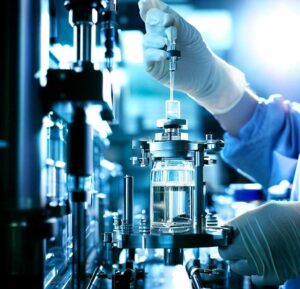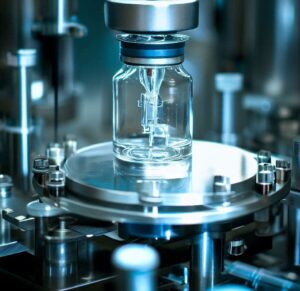Exploratory Phase
The first landmark in the journey of vaccine development is the exploratory phase. This pivotal stage acts as the starting block where possibilities are identified and predictions for future outcomes are contemplated. This integral part of the process is far removed from the general public’s view, but it is here where the initial spark of innovation is lit.
The exploratory phase is predominantly led by academic and industry researchers deeply engrossed in the world of molecular biology and infectious diseases. Their primary task during this phase is to utilize their extensive knowledge of pathogenic organisms — viruses, bacteria, and other microbes that are responsible for causing diseases. This intricate understanding paints a revealing picture of the microbes’ characteristics, their interaction with human cells, and the tricks they employ to dodge the immune system.

A central part of this phase involves spotting substances that provoke an immune response, known as antigens. Antigens may be isolated proteins from the organism or bits of its genetic material — either DNA or RNA. Occasionally, a whole microbe can serve as an antigen, wherein it is typically inactivated or attenuated (weakened) so it can’t cause illness but retains the ability to stimulate an immune response.
The quest for identifying potential antigens has a direct bearing on the effectiveness of the resultant vaccine. That’s because these antigens play the keystone role in shaping the immune response. A well-chosen antigen can convincingly simulate an infection, thus schooling the immune system accurately about the enemy it needs to defend against — all without causing the actual disease. This process equips the immune system with the knowledge needed to ward off the real infection when it attempts to invade in the future.
The identification of potential antigens is driven by numerous factors such as the antigen’s ability to elicit a strong immune response, its accessibility on the pathogen’s surface for antibodies, and safety considerations for the host.
Technology further intrudes into this phase. Bioinformatics, for instance, plays a staging role in antigen selection. By utilizing pathogen genomic databases and computational tools, researchers can predict which proteins are likely to be good antigens. In vitro assays are also employed to measure how well these antigens stimulate an immune response in cell cultures.
The exploratory phase is not devoid of challenges. Finding the right antigen is like finding a needle in a haystack, given the number of possible antigens a microbe can present. Nevertheless, the breakthroughs from this phase set the foundation toward creating a promising vaccine candidate that might one day turn the tide against lethal diseases.
Preclinical Phase
Moving forward, we enter the second stopover of this journey– the preclinical phase. Here, the identified antigens are used to develop prospective vaccine candidates which are then tested on cell cultures or animal models to evaluate their safety and capacity to induce an immune response. It’s vital to note that the success of a vaccine in this phase does not guarantee its success in humans; however, it gives the green light for progressing to the next stage.
Clinical Development
Next up is the clinical development stage, considered the most rigorous and time-intensive part of the process. This phase unfolds in three steps:
Phase I involves testing the vaccine on a small group of adults, typically between 20-80 subjects, to assess its safety, appropriate dosage, and ability to provoke an immune response.
Phase II expands the testing to include hundreds of participants. This phase serves to gather more data on safety and how well the vaccine works while starting to identify possible side effects.
Phase III involves large scale testing on thousands to tens of thousands of people to assess vaccine efficacy, monitor for any adverse reactions, and gather additional safety data.
The demographic of volunteers is crucial at this stage, including different groups like varying ages or people with chronic health conditions, which gives a diverse assessment of the vaccine’s effects.
Following the intricate dance of clinical trials is the regulatory review and approval phase. Organizations, such as the U.S. Food and Drug Administration (FDA) or the European Medicines Agency (EMA), begin the review process. These regulators look meticulously into the clinical trial data for the vaccine’s safety, efficacy, and manufacturing quality before casting a approval or rejecting the vaccine.
Manufacturing
Once the regulatory authorities give the green signal, the vaccine development process propels into another critical phase – manufacturing. This involves the mass production of the vaccine, potentially millions or even billions of doses depending on the severity and prevalence of the disease. It’s important to underscore here that manufacturing involves more than just putting together an intricate biological puzzle; it encapsulates the meticulous task of producing identical sets of this puzzle on a massive scale while abiding by high-quality standards.

Think of it as operating within an elaborate maze where every turn is dictated by precision and detail. Developing a successful vaccine formula in a lab is one thing; scaling up this process to manufacture quantities that can cater to global demand is an entirely different challenge. Economies of scale, logistics, ensuring continuity of supply chain for components, and keeping up with stringent deadlines often play vital roles here.
Quality control is of paramount importance at this stage. It stands as the cornerstone to ensure the safety, efficacy, and consistency of the vaccine across all production batches. Each batch of vaccines undergoing manufacturing is put under the magnifying glass, scrutinized, and tested rigorously at multiple junctures of the production process. This is to ascertain that every aliquot of the vaccine maintains the same standard of safety and effectiveness, irrespective of when or where it was manufactured.
Batch testing is a pivotal practice in the manufacturing process. It involves examining and validating the quality of the vaccine at various intervals during production. Each lot of vaccines is subject to rigorous quality checks, ranging from the purity of the antigen to the absence of contamination, the stability of the final product, and even the integrity of the vial and seal.
Highly specialized and sophisticated technologies are used for quality inspections. These may include high-performance liquid chromatography (HPLC) for separation and purification analysis, mass spectrometry for molecular weight analysis, and genome sequencing for identifying possible genetic contamination.
The manufacturing process is also governed by a stringent regulatory framework. In many countries, regulatory agencies require manufacturers to submit a sample of each vaccine batch along with their test results for independent verification before the batch can be released for distribution. This acts as an extra layer of safety cushion ensuring the delivery of safe and dependable vaccines to citizens.
Quality Control, Distribution, and Post-Marketing Surveillance
After manufacturing, the vaccine’s journey is still not over. Quality control continues as vaccines are stored, distributed, and administered – ensuring the journey from the factory to the patient maintains the vaccine’s integrity.
Once the vaccine is in usage, a post-marketing surveillance system monitors any adverse effects reported by healthcare providers or patients themselves. This critical phase helps identify any rare side effects not detected during clinical trials and assess long-term effects of the vaccine.
The process of vaccine development is a testament to the tenacity of human scientific endeavor. As we navigate these phases from exploratory to manufacturing and post-market surveillance, the complexity and precision involved create a trust in the science behind these life-saving tools.
As we look forward to the future of vaccine development, the hope is for an ever-evolving landscape that accommodates rapid response to new and emerging health threats – ensuring the continued health and wellbeing of populations globally.